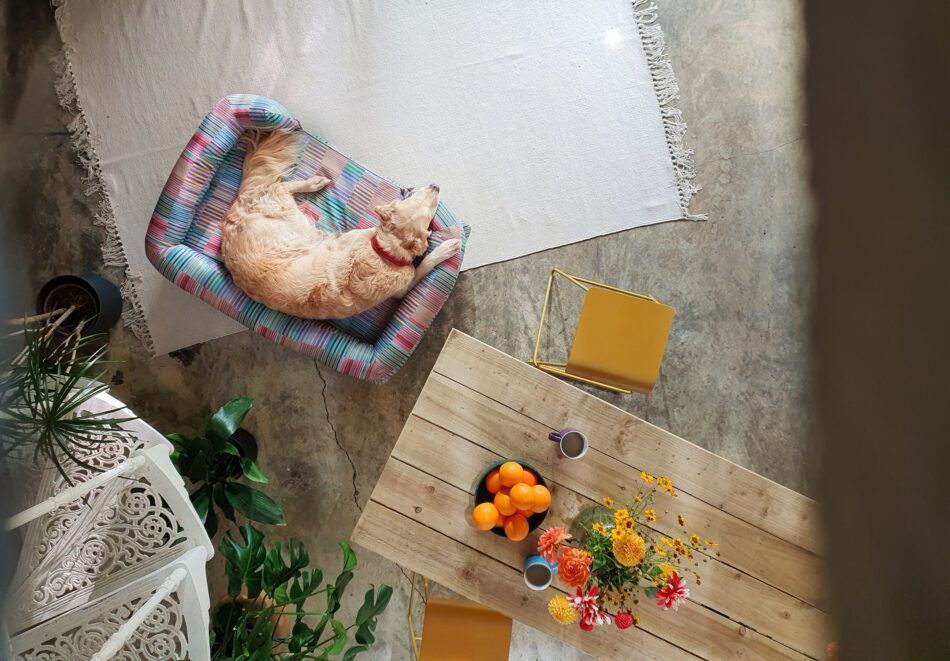
As a dog parent, you know what it’s like to try and keep a tidy house when you have a furry friend. With leashes, dog toys, and dog beds, your house can get cluttered quickly. And while you can hide the dog accessories in a basket or storage bin, concealing the dog bed can present more of a challenge.
How do you make sure your dog bed matches your decor? Thankfully, the task of incorporating your dog’s living space into your own has become much easier with ingenious products and designs. So before you go hiding another dog bed away in the corner, read these tips on how to make your dog’s bed a style staple in your home.
What are the best bed options for your dog?
After getting home from a long day at work, we all want a cozy and comfortable spot to relax and unwind. Your dog feels the same way. The bed your dog sleeps on is often not only their sleep sanctuary but their place of escape as well. So positioning a dog bed near a walkway or in a frequently traveled path of your home is not a good idea.
What if a dog bed could be enclosed like a personal doggy home? What if instead of a worn out pillow lying on the floor, your dog’s bed could be showcased like a piece of furniture? We asked ourselves these very questions and then challenged our product designers to create a solution. After all, giving your dog a space of their own is not only beneficial to their health and well-being, but it will also make your decor space look good while doing it.
Match your dog’s bed to your furnishings
If it’s not the space, but the look of your dog’s bed that is putting you off, it might be time to upgrade to a more stylish bed that matches your own sofa, bed sheets and cushions. Finding a dog bed that complements your decor is like finding the perfect throw pillow to complement your sofa. Just remember – style’s important, but comfort is king when it comes to dog beds.
Is your interior decor a neutral palette with warm and soft tones? Then perhaps a soft gray or neutral color dog bed printed in Pawsteps Natural will fit right in. But if your home decor is filled with bold and bright colors, opt for a dog bed to match your fun style! Try the Pawsteps Electric dog beds from our latest Dog Walk collection for the ultimate standout piece of doggy furniture. And even better, you can find a matching Dog Walk Collection collar and leash to complement your printed paradise.
A home within a home
Meet the Fido Nook Dog House, designed by Omlet. Engineered as an elegantly modern piece of furniture to complement your home while also providing a cozy space for your dog’s bed. Now you can create a space your dog can call their own while also using it as a functional spot to place plants, pictures or even your basket for keys. Any dog bed can fit inside the Nook but our Bolster dog bed fits in even more seamlessly! And by elevating your dog’s bed, you’ll raise their comfort and hygiene and protect them from dust balls, drafts and disturbances.
Having an enclosed dog den is a great way to add style and functionality to your interior. The Fido Nook comes with an optional doggy wardrobe storage where you can place all of your dog’s personal items. If it weren’t for the dog bed inside, you might just think the Nook is another sleek end table to enjoy.
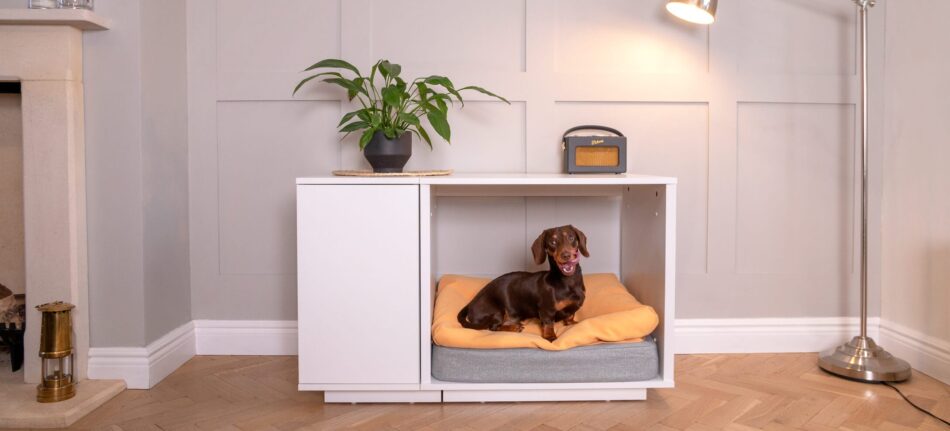
A stylish upgrade
To truly incorporate your dog’s bed into your interior, you can look to upgrade with accessories. Just like the blankets and pillows that adorn your couch and chairs, you can give your dog the same feeling of opulence with their own items.
A super soft dog blanket is the perfect way to upgrade your dog’s naps and your decor. Whether you drape it on their bed or over the sofa, adding a dog blanket brings texture and depth to your interior while also providing endless hours of additional comfort for your dog. It’s a win, win situation.
For the standalone dog beds, you can heighten the luxury look and your dog’s health by simply adding feet to the base of the bed. With the Omlet line of dog bed feet, you can choose from a variety of different looks and styles including wood, gold hairpin and modern metal rails. Match the feet to the tones and textures of your decor to enhance the look and feel of your space. And your dog will appreciate an elevated level of comfort and hygiene in the process.
The Omlet design options
At Omlet, we believe dogs are family members, too. So where they sleep and spend their time should be reflected in your home. Incorporating your dog’s bed into your decor doesn’t have to be difficult. And once you’ve decided if you want a dog den or just a dog bed, you can start customizing to match your interior design needs and the needs of your dog. With countless options and products, we make matching your dog bed to your decor a breeze.
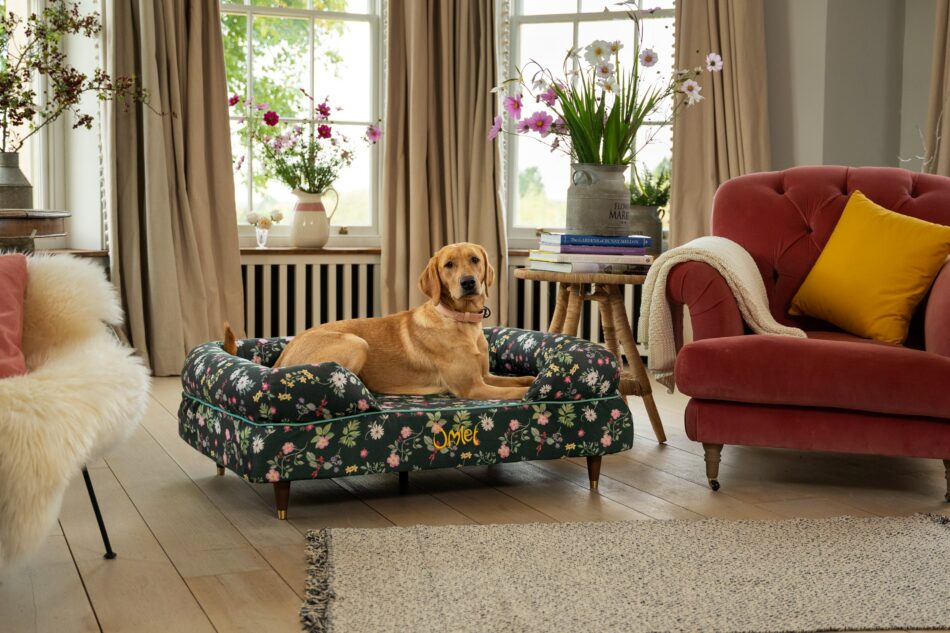
This entry was posted in Dogs on February 26th, 2020 by linnearask

All rabbits, whether they live in burrows in the wild or in a comfy hutch and are kept as pets, are herbivores. This means that they exclusively eat things that come from plants, mainly grasses, seeds and vegetables.
The largest cause of illness in pet rabbits can be traced back to dangerous or wrongly proportioned feeding. Apart from life threatening gastrointestinal diseases, a poor diet can also cause teeth problems and weakened immune system, so it’s very important that you learn how to feed your pet properly.
HAY
A wild rabbit’s diet will consist almost exclusively of grass that they find on and around their warrens. As grass contains very little nutrition, they need to eat large amounts to survive, and spend most of their days looking for and munching fresh grass. Pet rabbits won’t be able to eat this much in a day, so their diets must be supplemented with dry food, vegetables and hay to get the calories, vitamins and minerals they need to stay happy and healthy.
A good rabbit diet should consist of about 80% good quality hay, and they should always have an unlimited amount available to them. They hay does not only give the rabbits the nutrients they need, it also helps them wear down their constantly growing teeth. It’s not enough to just make sure the rabbits always have access to hay; you must also limit other types of food, as they will often be prioritised at the expense of hay intake.
FEED
The most common types of feed for pet rabbits are pellets and food mixes. Pellets are always the better option here, as it has a higher fiber content (at least 18%, ideally 20-25%) and is not as high in fat and unhealthy carbohydrates, like sugar. Pellets also prevent selective feeding, as the nutrients are evenly spread in each pellet, so that you can be sure all your rabbits get the same food.
Only feed a small amount of pellets every day. As mentioned earlier, a rabbit that is fed too much other yummy things will prioritise these over the very important hay.
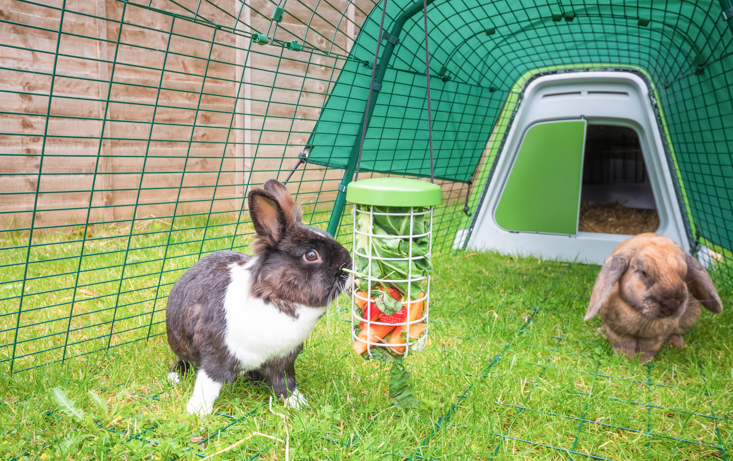 GREENS
GREENS
Fresh greens are a great source of nutrients for rabbits, and the different chewing motions will help with wearing teeth down. Try to give your pet a wide variety of greens throughout the week, and aim for three different types per day. Some good examples include grass, clover, dandelion leaves, leaves from fruit trees, carrot tops and parsley. Spinach, chard, cabbage and sprouts are also nutritious, but must be given in moderation. In general, introduce new vegetables slowly, and look out for any signs of an upset stomach.
Make sure that the greens you feed your rabbits stay fresh by putting them in a treat holder, like the Caddi. This makes feeding your rabbits easy and hygenic, while also providing your pets with a fun and interactive experience of foraging their treats.
TREATS
Other vegetables, fruits and berries can be fed in small amounts every now and then. Avoid any “human food” containing sugar or salt, as well as nuts and seeds. It’s tempting to spoil your pet, but if it’s not done in moderation, your rabbit might end up obese and ill.
It’s also important to note that some fruit and vegetables are dangerous or even toxic to rabbits, and must be avoided at all times. Before you try something new, make sure you check that it is okay for rabbits.
CAECOTROPHES
In order to get the most nutrients out of the food they eat, a rabbit will produce small, dark, grape-like balls, different from the normal pellets, that they eat straight from their bum. It may seem strange to us, but it’s very important that they eat these extremely nutritious snacks.
If you notice lots of these caecotrophes scattered around the hutch, or if they are getting stuck in the fur around the rabbit’s bottom, it’s a sign that the rabbit’s diet is too rich. Try cutting down on pellets and add more hay, and contact your vet if the problem persists.
This entry was posted in Rabbits on February 25th, 2020 by linnearask
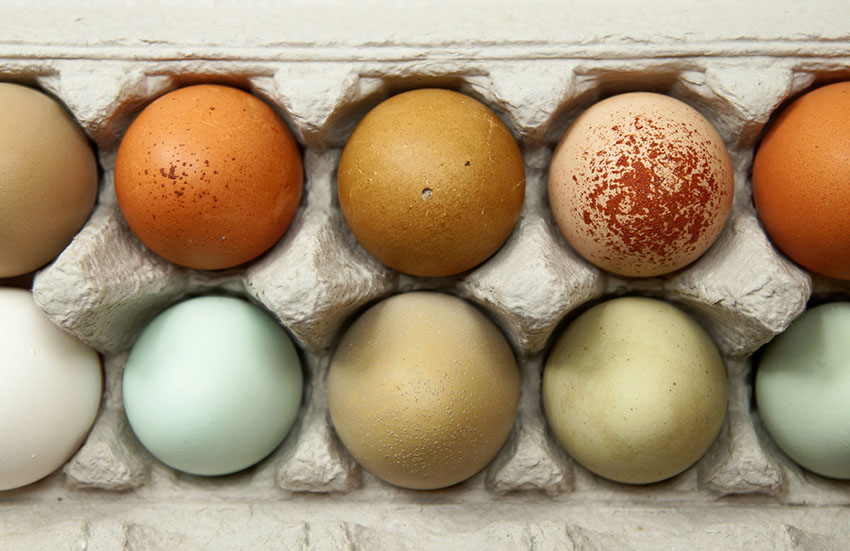
The ancestor of all chickens is the Red Junglefowl, Gallus gallus, a native of South-east Asia. All Junglefowl eggs have shells of a creamy white colour. And yet, as any chicken keeper knows, the eggs of domestic hens can vary widely.
Many years ago British chicken egg producers realised that shoppers favoured brown eggs, and turned their noses up at white ones. It was even said that brown eggs were more nutritious (which is not the case – all chicken eggs have the same nutritional value).
This tyranny of supermarket brown eggs continued until about 20 years ago, when a niche market was created for eggs from specific breeds. Chocolate browns, blues, and even the much-maligned whites, all began to appear on the shelves.
But for anyone familiar with backyard chickens, this was nothing new. Pearly whites from the Sussex and Leghorn, lovely blues from the Ameraucana and Cream Legbar, red-brown beauties from the Barnevelder and Welsummer and the dreamy greeny-blue of the Araucana and Favaucana are all in a day’s egg-collecting.
But why, given the fact that those ancestral chickens all laid creamy white eggs, do these different colours exist?
Egg Painting – the Natural Way
An egg takes around 26 hours to fully form inside a hen. Twenty of those hours are dedicated to toughening and colouring the egg shell. Layers of calcium carbonate provide the toughening – which is why hens need plenty of calcium in their diets – and the colouring is down to pigments. Calcium carbonate is naturally white, so any other colour has to be ‘painted on’, from the inside.
Breeders have created hundreds of chicken varieties over the centuries, and each of these has distinctive plumage and colouring. The pigments that give feathers colour sometimes go hand in hand with specific pigments for colouring egg shells too.
For example, the Ameraucana carries the blue pigment biliverdin, and this is painted onto the shell in the later stages of the egg’s development in the oviduct. Both the outside and inside of the shell have the same blue colour.
This is not the case with a standard brown egg. Crack one open and you’ll notice it’s white on the inside. The pigment responsible for brown colouring is protoporphyrin. This is present to a greater or lesser degree on the majority of chickens. Even eggs of a creamy colour have a hint of protoporphyrin in their shells. Hens carrying an excess of the pigment – such as the Delaware and Marans – produce fabulous chocolate brown eggs.
Many hens lay brown eggs dappled with darker brown spots and streaks. The Neera and Welsummer are good examples of this. The effect is causes by the egg turning as it makes its way through the oviduct, and it is a common feature in the eggs of many wild bird species. It is details like this that enable owners to recognise eggs from their individual birds (in a small flock, that is!)
When the two types of pigment – the blue and the brown – are mixed together, the result is a greenish blue or olive colour. If the brown pigment is light, as in the Favaucana and Araucana, the eggs are a soft greeny blue. With a darker brown in the mix, the olive colour is increased, as in the aptly named Olive Egger.
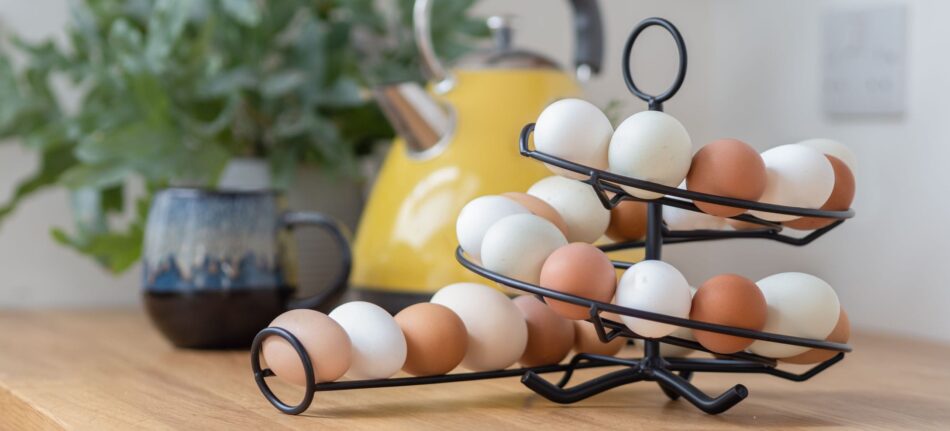
What Colour Are Your Chickens’ Earlobes?
It can come as a shock to learn that chickens have earlobes. Even more surprising to hear that these lobes give a clue to the colour of egg shells.
The earlobes are obvious, once they’ve been pointed out. Chickens have three types of ‘wattle’ – the red crest, the wobbly ones on the throat, and the ones on the side of the head, towards the back – the earlobes.
White earlobes are found on hens with white or otherwise pale plumage. These birds have relatively small amounts of pigment, hence the light feathers. The same rule applies to the eggs – no pigment, and hence white eggs. Meanwhile, hens with brown or reddish earlobes lay brown eggs, and ones with a creamy, pearly, shiny white earlobes lay blue eggs.
These days, ironically, it is the non-standard-brown eggs that command the higher prices in the shops. And yet once you get a clutch of golden-yoked, grass-fed, free range chicken eggs cooking side by side in a pan, you can’t tell which shell produced which egg. When it comes to chicken eggs, beauty is indeed in the eye of the beholder – and the earlobe of the chicken!
This entry was posted in Chickens on February 19th, 2020 by linnearask

Scratching is to cats as tail-wagging is to dogs – it’s a completely intrinsic behaviour that is healthy for them to engage in. But how does scratching help cats? In many ways, actually! The act of scratching for cats is an emotional release to get rid of any stress or excitement, but it’s also a necessary act that allows them to keep their claws maintained and give their body a good stretch. And that’s precisely why cats need scratching posts so they can have a safe place to participate in this normal feline activity.
4 reasons your cat needs to scratch
The act of scratching for cats isn’t second nature – it’s in fact, first nature. A primal instinct that is part of their innate feline behaviour, cats scratch for a variety of reasons to help both their bodies and their minds.
- Maintain their claws: In the wild, cats use logs or trees to scratch so they can sharpen their claws and clean away any dirt or debris trapped in their paws. Akin to a manicure, cats can actually trim their nails and keep them manageable with one scratching post-session.
- Stretching: What’s better than a full-body stretch first thing in the morning? If you ask your cat, the answer is nothing. When cats scratch on a cat scratching post they’re able to stretch out their body, legs, and paws to give themselves the necessary movement in their muscles to keep them healthy and strong.
- Emotional release: There’s no doubt cats enjoy the act of scratching for physical reasons, but engaging in this natural activity is actually super beneficial to their mental well-being as well. When cats scratch, they’re able to release any pent-up stress or excitement to calm themselves emotionally in a way that best serves their state of mind.
- Scent marking: Did you know that cats use scratching as a communication tool? With tiny scent glands located all over their paws, cats use scratching as a way to ‘mark their territory’ and tell other animals that this is their domain.
5 benefits of scratching posts for felines
Cat scratching posts are more than just a feline fitness centre where your furry friend can exercise their physical, mental, and emotional needs. With their sturdy platform and alluring nature, cat scratching posts are the saving grace for your furniture so they can stay claw and paw-free. Let’s take a closer look at all the benefits of cat scratching posts:
- Prevents furniture scratching: Your cat needs to scratch. So having a durable and sturdy scratching post allows your feline friend the ability to perform their innate behaviour while keeping your furniture claw-free.
- Release stress: How do you destress after a hard day at work? While cats make living look easy, our feline friends are still susceptible to feelings of stress as well. And with a scratching post, your cat can release any feelings of excitement or worry that has built up in a healthy and engaging way.
- Claw care: As a cat parent, you know all too well that trying to give your cat a manicure is out of the question. So how do you keep your kitty’s claws clean and cut down? With a cat scratching post, of course.
- Encourages exercise: Keeping your cat active is essential to their overall health. And since most cats won’t agree to a walk around the block on a leash, the act of scratching provides the necessary exercise they need. Especially for cats who don’t have the opportunity to go outside, a sturdy cat scratching post allows your feline friend the ability to stretch and move in a way they love.
- Promotes feline interaction: If your home is a multi-cat household then the benefits of scratching posts are far-reaching. While you can certainly get one scratching post for each cat, having just one for them to share encourages positive interactions and is a great way for them to get along.
Should kittens have their own scratching post?
As the toddlers of the cat world, kittens have lots of energy! And in order to ensure they get a good night’s cat nap, it’s essential to find a way to encourage ways for them to expel that energy. A scratching post is an excellent way for your kitten to get their ‘wiggles’ out before bed and also learn healthy ways to express their natural instincts. Giving them a dedicated space all their own not only prevents unwanted scratches on your furniture, but also helps to create positive behaviour as they grow into adulthood.
Introducing Omlet’s sustainable cat scratching posts
At Omlet, we understand cats and their innate, primal instincts. It’s what allows us to think outside the box and create products that bring you and your pet closer together. So when we set out to design a new cat scratching post, we challenged our designers to create a product that your feline friend would not only love, but would stand the test of claws while also looking good in your home.
Introducing the Stak Cat scratching post, designed by Omlet. A sleek and sturdy post crafted completely from sustainable materials to allow your cat endless scratching sessions. The Stak challenges the cat care norm of consumable scratchers with its refillable, stackable cardboard triangles so your cat never runs out of something to scratch, and you don’t have to worry about ever buying another scratching post. This is literally the last cat scratching post you’ll ever buy. Because kittens and cats scratch every day, we curated this post to be the one they would use daily – for life. When the cardboard gets worn down, simply remove them and recycle and replace with new Stak triangles.
Preventing your furry friends from scratching the furniture
While the cat scratching post is away, the feline will find something else to scratch. So if you find your furry friend exercising their claws on your walls, carpet, or sofa, it’s time to redirect this destructive behaviour to something more beneficial. Here are our top tips on breaking your cat’s habit of scratching on the furniture:
- First and foremost, introduce your cat to a cat scratching post. In order to encourage your feline to use the post instead of your leather chair or wool rug, sprinkle some catnip on the scratching post. The irresistible scent of the catnip will make the scratching post your furry friend’s new favourite place to scratch.
- Cats are particular – especially when it comes to scratching surfaces. So if the sofa and armchair are their favourite places to sharpen their claws, cover them with materials that will leave your cat displeased and looking for something else. Tin foil, double-sided tape, or Saran Wrap are all surfaces that will deter destructive clawing and make them move to a better surface such as a scratching post.
- One of the best parts of cat parenting is the post-workday snuggles on the sofa with your favourite furry friend. But what if the cat sofa surfing leads to cat sofa clawing? Simply cover their spot with a cosy cat blanket to encourage snuggling instead of scratching.
- If you start to hear your cat scratching the walls of their litter box, it may be their way of telling you they want more privacy. And you can’t blame them! So give your cat what they want with an enclosed cat litter box and perhaps even a private cat house so they can destress with ease wherever they are.
- It’s known throughout the animal world that certain smells are off-limits to certain species. And cats are no exception. So if you have a repeat furniture-scratching offender in the house, try spraying citrus or menthol scents on the areas you want them to stay away from. These odours are sure to deter the most persistent of scratchers.
Training your feline to use their new scratching post
The most important thing to remember when buying a cat scratching post is the specific needs and scratch styles of your cat. Do you have a pint-sized puss or a tall and long feline? Does your cat like to scratch on their hind legs or while lying down? Making sure you provide your cat with a scratching post that is appealing to their size and needs will better ensure their use of the post over anything else.
Finding a cat scratching post that is sturdy and wide is another important feature to consider. A strong, heavy base will help prevent the scratching post from falling over during a scratch session and allow even the tallest of cats to reach full stretch potential. Next, make sure the cat scratching post is covered in material with vertical grooves rather than horizontal to allow for the ultimate scratching experience. Cardboard is an excellent choice with its corrugated fibres that help eliminate the chance of snagged claws when scratching.
Once you have the perfect cat scratching post picked out all that is left is introducing your feline friend to their new friend. Be sure to place the scratching post in an area frequented by your cat so they can get accustomed to the new equipment quickly. And any time they mistake your furniture as a still acceptable scratching option, simply redirect the behaviour by placing the scratching post in front of them. Cats are curious but also very clever so they will catch on in no time.
How time outdoors impacts your cat’s need to scratch
Domestic cats can be found living indoors, outdoors, or a combination of both in homes all across the country. And while every cat needs an outlet to express their natural scratching instincts, outdoor cats don’t need as many scratching accessories inside the home as they are able to exercise those needs very well outside. Just like their wild ancestors, outdoor cats use trees or other natural surfaces to manicure their claws, release any tension, and get a good ol’ fashion exercise.
So if your cat stays indoors more than out, consider creating a safe outside environment where they can not only play, but help discourage indoor scratching. If you have a spacious garden, you can add an outdoor Catio enclosure where your feline friend can explore nature in a secure structure. Live in an apartment or condo with no garden? No problem! Create a cat-proof balcony with a balcony cat enclosure. Your feline friend will love the fresh air and natural environment to exercise their instincts and you will love keeping your furniture and walls scratch-free.
Identifying stress in your feline
When cats are stressed, they have a tendency to release their emotions through their claws. And that’s when your furniture could be in real danger! So in order to avoid cat-scratch-fever on your belongings, pay close attention to what is causing the stress in your cat so you can help eliminate it from happening in the first place.
There are a variety of reasons why cats exhibit a stress response – it could be another cat, another pet (usually the dog), or even a child in the home who has done something to freak out your poor puss. In other instances, it may just be the hum of the dishwasher or even a jet plane flying by that could trigger their emotions.
Paying close attention to your cat’s behaviours before they start scratching can give you better clues to the cause and help you to minimize or remove the source altogether. And adding a second cat scratching post will encourage their instinctual behaviour to be released in a healthy and less destructive manner.
Breeds least likely to scratch
If you’re just starting out on your cat parenting journey and scratching is a big concern, fear not. There are some cat breeds that are less likely to scratch when given a good cat scratching post as an outlet. Here are our top cat breeds that are more likely to snuggle on your furniture than scratch it:
In general, cat breeds that are more likely to scratch with frequency are also the cats with high-energy personalities. While this can certainly differ from cat to cat, breeds such as Bengals and Siberians tend to have a greater need to scratch more often.
Cat care with Omlet
At Omlet, our goal is simple – make products that help care for your pet in the best way possible. From cat scratching posts, to comfy cat beds, to outdoor cat trees or cat litter, we have everything you need to make life with your cat better. And when you give your cat everything they need, you can both focus on doing more of what you both love – spending quality time together.
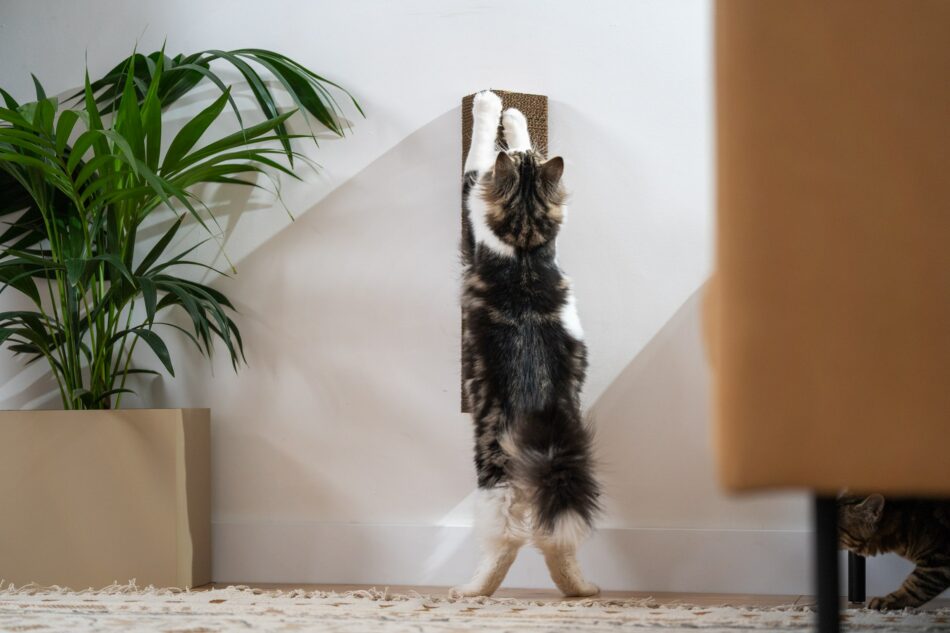

This entry was posted in Cats on February 17th, 2020 by linnearask
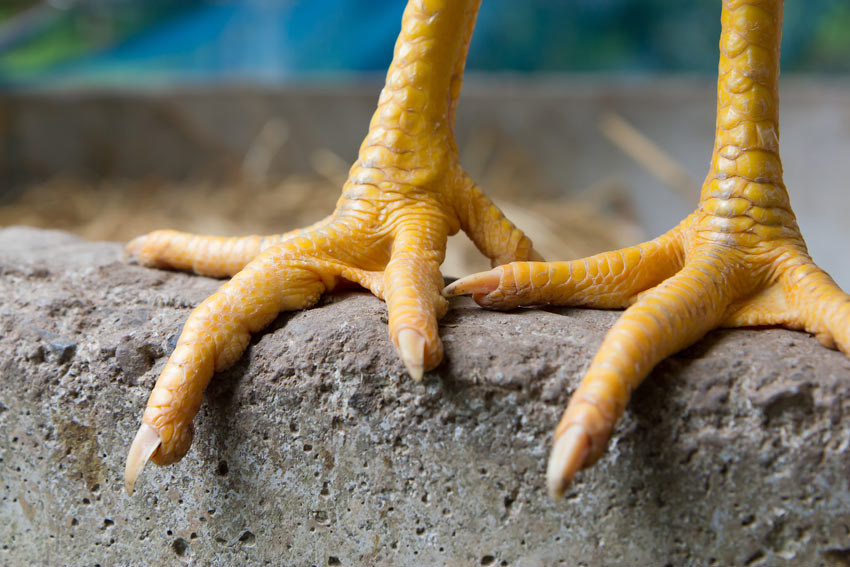 Watching chickens scratch at the frozen ground or strut through the snow, you might wonder how they manage to keep their feet and legs warm. After all, this is one part of their body with no feathers to keep it cosy (unless you happen to have a feathery-legged breed such as the Cochin, Brahma or Silkie).
Watching chickens scratch at the frozen ground or strut through the snow, you might wonder how they manage to keep their feet and legs warm. After all, this is one part of their body with no feathers to keep it cosy (unless you happen to have a feathery-legged breed such as the Cochin, Brahma or Silkie).
Surprisingly, the simple answer to ‘How do they keep their leg warm?’ is ‘They don’t!’ Those skinny, bare legs have scales, which retain heat to a certain extent, but they will still get very cold if the bird stands still for too long.
And that’s the important detail. A chicken keeps its legs warm by moving, and by not keeping all its toes on the ground for too long. These parts of their body lose heat rapidly; but the solution is quite simple.
Perching is the most effective way of retaining heat. A hen hunkers down when roosting, and her legs are tucked into her warm body. If space allows, install a flat perch too. A piece of wood with a 10 cm width will enable the hens to roost without having to grip the perch, which in really cold weather will prevent their toes freezing. (The lucky ones will simply snuggle down in a nesting box, which is the chicken equivalent of a thick quilt!)
But of course, a hungry hen doesn’t want to waste the whole day perching, so even in the coldest spells she will make a lot of contact with the ground.
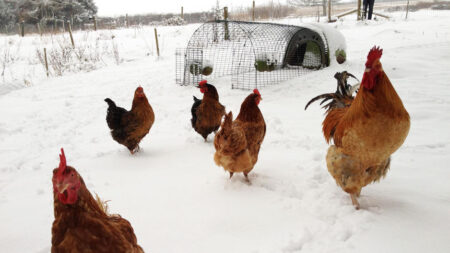
One-Legged Hens
Like many other birds, chickens often adopt the ‘one leg’ look, tucking one of their limbs up into the warmth of their bellies. This reduces overall heat loss and stops feet and toes from freezing on the icy ground.
An upturned pot, a log, pallet or other slightly elevated space – cleared of snow or ice – will help the hens get the circulation going again, without having to catch their breath on the frozen ground. Like all birds, chickens are warm-blooded, just like us, and their own body heat soon works its magic. Indeed, with an average body temperature of around 41°C, chickens can remain active in the coldest weather.
The leg-warming process is helped by other tricks, too. Fluffing up the feathers retains body heat, by trapping small pockets of air which are then heated up by the bird’s warm body.
Some owners give their hens a supper of corn and grains, which take longer to digest than a standard pellet or other chicken food. Part of the digestion process involves producing heat – a kind of internal hot water bottle!
In general, hens will eat more food in the cold months, as more of their energy is spent keeping warm. Some owners like to supplement the birds’ diets with extra protein or a little suet, to increase their fat levels for the winter. Fat retains heat, and the whole bird benefits – not just the legs (which will remain as thin as ever!)
Help With The Heating
You can help your hens keep their toes cosy by making sure the coop is clean and dry. Clear out any snow dragged in on the birds’ feet, and keep an insulating layer of straw on the floor. You can give the birds extra protection by insulating the coop – although there should still be some ventilation, to allow the gases released from the birds’ droppings to escape.
You can install an automatic door to help keep the living quarters snug. Heaters are also available – but never use anything other than a heater designed specifically for hen houses. It’s also best to use these only if the temperature gets below -5°C, otherwise hens may get used to being cosy all the time, and that could be disastrous if the heater fails and the birds are suddenly exposed. Heat-pampered poultry can die of cold shock.
A coop should be draft-free, but not completely sealed, as ventilation is important for healthy hens. During the day, a sheltered spot in the run or garden will help them take a breather and warm those long-suffering legs.
Chickens are amazingly hardy, and although not exactly warm, their legs will be able to cope with anything the average winter throws at them. As long as they can toast their toes on a nice perch every now and then…
This entry was posted in Chickens on February 14th, 2020 by linnearask
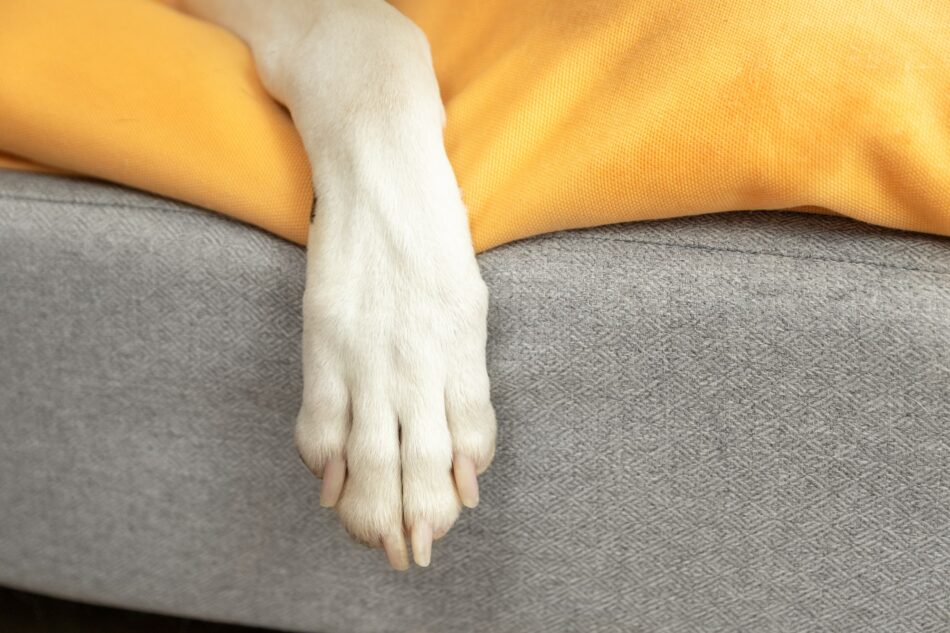
In the intricate tapestry of the animal kingdom, the paw stands as a remarkable adaptation and a testament to evolution’s creativity. From the stealthy cat’s paw to the unique polydactyl paws of the guinea pig, these appendages are diverse, functional, and revealing. But why do some animals have paws? In this guide, we journey through the history of the paw and unveil the fascinating insights that paws offer about the wonderful animals that bear them.
History of the paw
The story of the paw unfolds across millennia, tracing back to the evolutionary emergence of the first creatures to venture onto land from water. Limbs evolved into diverse forms to navigate various terrains, leading to the development of paws. These adaptive structures equipped animals with the ability to walk, climb, dig, swim, and manipulate objects, serving as the cornerstone for survival.
Before our pets were domesticated, they had to defend themselves to stay alive while hunting for their own food. While domestication has quieted many of those innate traits, still several haven’t changed, staying with the species throughout evolution. This includes the paw.
Dogs and cats are the main paw-ed animals that may come to mind. But before we had house cats and dogs, there were generations of wild cats and wolves roaming the Earth. In the wild, the main purpose of the paw was largely related to sound and shock absorption. The fatty tissue inside the pads helps animals jump and land without pain or noise which was especially helpful for silently hunting prey in the wild while also protecting limbs from impact.
The evolution of the paw is as fascinating as the evolution of mankind – every change significant for its new environment and needs. So if your best friend has four paws, it’s best to know them like the back of your hand.
What can the paw tell us?
Animal paws hold a great deal of information in letting us know and understand how our furry friends are feeling. For instance, did you know cats knead blankets and pillows when they’re feeling safe and content? And for some animals, they use their paws as a way to release sweat and cool down. Here’s a breakdown of some of the many details that we can learn from the paw.
Functionality over form
Paws, despite their differences in appearance, share a common purpose: functionality. Whether it’s the padded feet of a feline or the webbed toes of an otter, each paw is intricately designed to suit the lifestyle and habitat of the animal.
Insight into locomotion
The structure of paws reveals clues about an animal’s mode of locomotion. For instance, the cat paw is designed for pouncing, jumping, and clawing through nature. This is why having a sturdy cat scratching post for your feline friend is essential to support their natural instincts. Each animal possesses unique traits in their paws which lends themselves to their survival.
Environmental adaptations
Paws serve as a mirror reflecting an animal’s environment. For example, animals dwelling in snowy landscapes often sport larger, broader paws, providing better traction and acting as natural snowshoes. In contrast, animals in arid regions, such as the desert, might have padded paws to better endure hot surfaces.
Sensory significance
Paws are not merely appendages for movement; they’re sensory hubs of communication. The paw pads of animals are rich in nerve endings which gives them a heightened sense of touch. So as pet parents, it’s super important to be mindful of temperatures for your furry friend so you can accommodate them as needed. When the summer heat rises, be sure you have a memory foam dog cooling mat or ultra comfy cat cooling mat to help their sensitive paws get some relief.
Health clues
Observing an animal’s paws can also offer insights into its health. For example, if your dog’s paws have an unusual odour or the hair is overgrown between the paw pads, this could be an indicator of an ailment requiring veterinarian treatment. Likewise, bumblefoot, a common infection that can appear on guinea pig paws, is a sign that treatment is needed as well. Allergies remain the most common problem that dogs and cats have with their paws – noted especially by excessive licking or chewing at their feet. When was the last time you looked at your furry friend’s paws?
Omlet and your pets’ paws
The enigma of the paw extends beyond its physical presence; it embodies the evolutionary journey, environmental adaptation, and behavioural nuances of the diverse animals in our world. At Omlet we understand the significance of pets’ paws and create products to serve as a reminder of the marvels crafted by evolution. From cat scratching posts with lights and dog beds with customisable toppers, our products help captivate stories hidden within the very footsteps of our favourite furry friends.

This entry was posted in Cats on February 12th, 2020 by chloewelch
With Valentine’s Day approaching many of us will be making restaurant bookings and buying cinema tickets for a night out with their partner. Sure, that’s nice, but wouldn’t you really prefer it if you could include the third member of your couple, your pet, in your plans? We’ve put together a suggested date night schedule that both humans and pets will enjoy, so that no one gets left out!
A few days before
If you’re buying a present for your parter, you should make sure you treat your pet to something special as well, as they’ve been such a good boy or girl. How about getting your rabbits or guinea pig some fun accessories for their run, like a shelter or some Zippi-tunnels? Dogs and cats will always appreciate a new, super comfy bed, like the super luxurious Omlet Bolster Bed.
16.00 Time Outside
Depending on what pet you have, the key to a good date night might be to tire them out a bit before you snuggle up inside. Rabbits and guinea pigs will love a run around in their tunnels in the garden, cats will enjoy some fresh air (either letting them hunt around the neighbourhood for an hour or so, or join them for some time on their cat run) and dogs will feel spoiled after a long hike or trip to the park to see some doggy friends. If you have a dog, why not stop off at a dog friendly pub for a drink and a small snack before you return home?
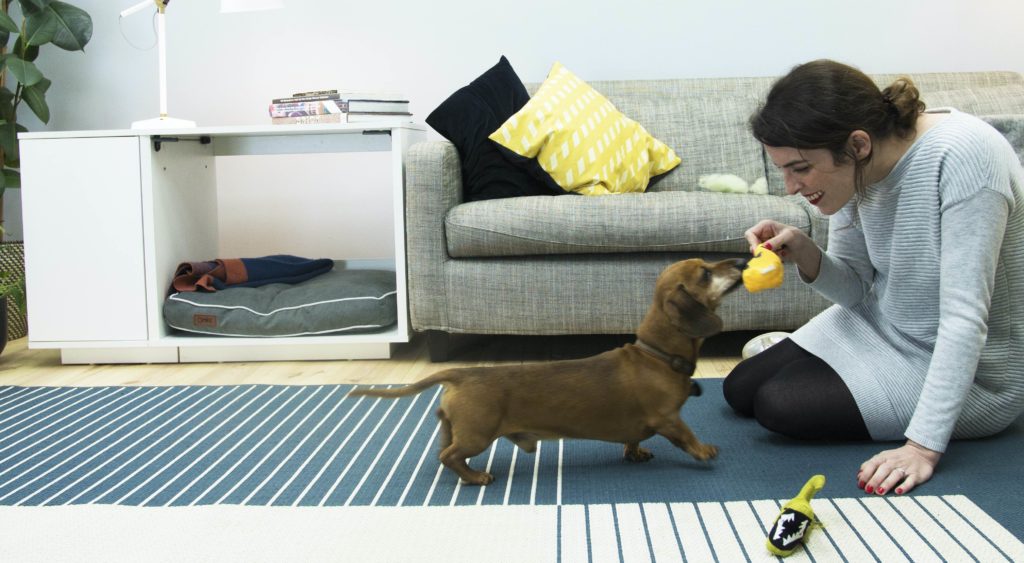
18.00 Play Time
This is a perfect opportunity to spend some quality time with your pet, doing what you know they love doing. If you have a smaller animal, you and your partner can create a maze or prepare a scavenger hunt for them, hiding snacks and building obstacles around the living room. Cats will enjoy chasing toys, and dogs will go crazy for some tug of war. If you want to spoil your pets even more, why not get them a new toy to play with?
19.00 Dinner Time
The key to the perfect date night is some good, and preferably rather indulgent, food. Maybe this is a good opportunity to try one of those recipes that requires a bit more time and effort? Or just to order some take away, if you’re knackered after all the playing. To fully include your pet, we would suggest making sure they also get to have something special for dinner. There are plenty of easy and healthy recipes for all pets online, so you can find something that you will enjoy making, and your pet will enjoy wolfing down. Divide the work and let your partner make something for the pets while you cook the human food, or the other way around.
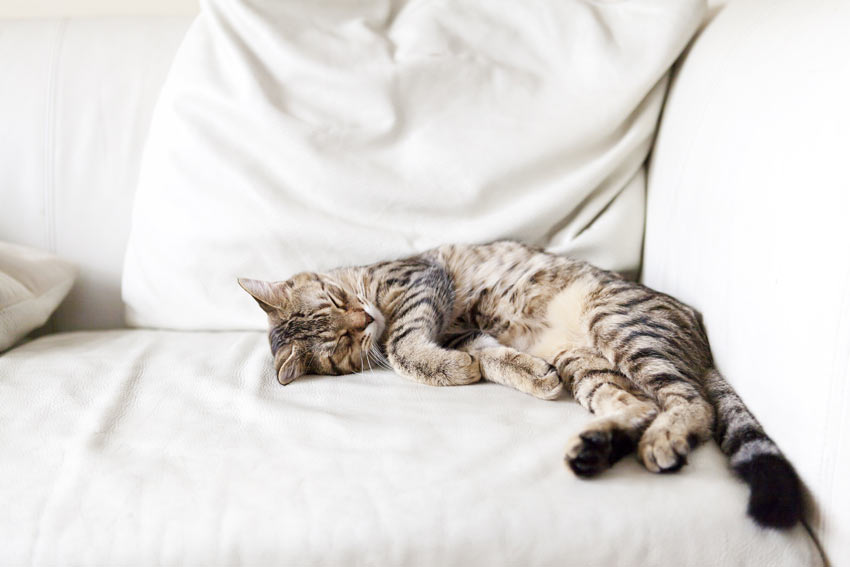 20.00 Spa Treatment
20.00 Spa Treatment
Get settled on the sofa for a pampering session for pets and humans alike. Give your pet a bath and some grooming, like cutting their nails, brushing their fur and cleaning their teeth. While you enjoy a face mask or a manicure, dogs and cats might benefit from an oil treatment for dry skin and paw pads. Finish off the spa hour with a good long massage. Your pet will probably not be of much help here, so you humans might have to take it in turn.
While you’re treating yourselves, why not put on some relaxing music? Spotify has recently launched Spotify for Pets, customised lists based on your pet’s personality and your music taste. Unfortunately you’re limited to only a few pets at the moment, but what’s to say your rabbit won’t enjoy a cat playlist?
21.00 Film and Snacks
Pop some popcorn, pour some wine and curl up on the sofa together with your date(s) for some Petflix and Chill. Make sure your pet has a place where he or she can get settled and feel comfy, maybe on a special blanket or bed. Date night is all about a relaxing rom-com, or something else that both you can your pet will love napping in front of. Make sure that you offer your pet movie snacks and a nice drink as well, we have plenty of treats and goodies for all pets in our shop, including white and rosé Pawsecco for a true celebratory evening . As an added bonus, you currently get 25% off all treats in the Omlet shop!
This entry was posted in Pets on February 9th, 2020 by linnearask

There is something very arrogant in assuming that only humans can experience deep emotions. We’ve all seen our pets excited and happy, and we also come to recognise when they’re sad. In other words, they experience feelings.
Sorrow in an animal is different from fear or anxiety. The latter things are brought on by stress, resulting from poor environment, poor diet, scary neighbours, cruel owners, or countless other factors that can make animals feel exposed or in danger.
Heartbreak, as any person who has experienced it knows, is something very different. It results from bereavement, or other forms of fundamental loss. Scientists are often eager to point out that we can never prove an animal feels these emotions. But many owners have seen it for themselves and have no doubt at all.
What Makes Dogs Sad?
A pet may become distressed if a certain person or a longstanding companion of the same species is no longer around – but only if that person or pet was one that the animal had completely bonded with.
A family dog will have a relationship with all the human members of its family, but there will usually be one favourite – an Alpha male or Alpha Female, if you like. Although the dog may miss the others, it is on this favourite, its main owner, that its affections will be focused.
If such a person leaves the household, for whatever reason, the dog’s first reaction will be one of separation anxiety. It will pine and lose its interest in things such as food, games and walks. Loss of appetite can lead to liver problems in a relatively short time, so keep an eye on the situation and be ready to turn to a vet for help.
The dog may also whine and cry more than usual, and may start to lick and chew household items, or its own fur or paws. Many grieving dogs find it hard sleeping, and will sit and whine by a door, or may simply go into hiding.
A lot depends on the breed, and on the individual animal too. But many dogs can certainly be classed as heartbroken in these situations. The grieving will last for several weeks, even months.
Time will cure the heartache, but in the meantime you can help by making sure the pet continues to have walks in its favourite places. If the dog enjoys staying in kennels, a short break there is a possibility too. You could also consider employing a dog walker, to give your pet a change of routine. Don’t be afraid to be more generous than usual with the snacks, treats and toys, too.
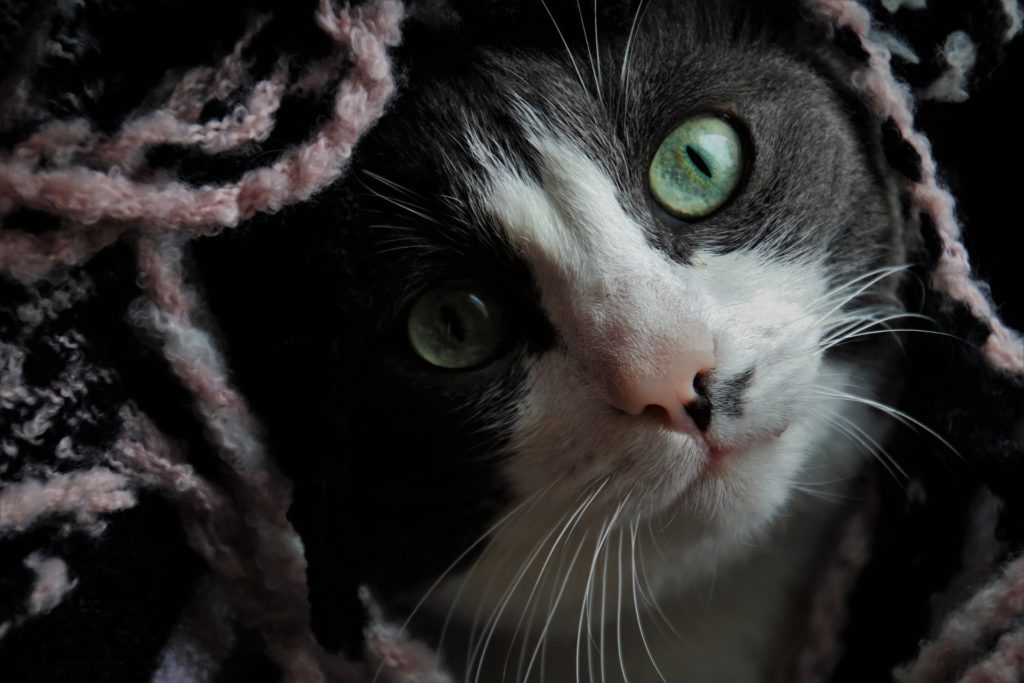 What Makes Cats Sad?
What Makes Cats Sad?
Cats can be harder to read than dogs. They will tend to lay low, hiding away more than usual. Some will become more vocal, mewing and crying for their lost friend. Many will lose their appetites, sleep less, and may even run away for days at a time.
Like dogs, a cat that stops eating can develop potentially fatal liver disease, so early intervention by a vet is recommended.
Many, however, soon transfer their main affections to another member of the household. Other, more independent cats seem to readjust without any problem.
What Makes Other Pets Sad?
Small mammals don’t appear to grieve when their owners disappear from their lives. But many will revert to a natural nervousness if they are no longer being handled and fed by their best friend. Someone else needs to step up and become the pet’s favourite.
Pet parrots who have bonded with a partner or owner are known to grieve the loss of a loved one, whether a fellow bird or a human. Loss of appetite and listlessness are the usual signs. Someone needs to keep up the contact and interaction, to ease these highly intelligent birds into their new lives.
The problem does not usually arise if the birds are kept in an open aviary setting. Smaller parrots such as budgies and lovebirds don’t seem to miss their human friends so intensely either, although they will certainly grieve if their feathered best friend disappears.
The Grieving Process
Above all, try to be upbeat and affectionate with the grieving animal. Pets pick up on our moods with an almost supernatural skill, so if we’re very sad, they may mirror our feelings. Again, this might be a good time to bring in friends or relatives more able to put on a happy face for the sake of the heartbroken pet.
Most pets will, with time, move on. Some older pets may never entirely recover. In all circumstances involving loss, all an owner can do is care for the animal as it readjusts to changed circumstances.
This entry was posted in Cats on February 8th, 2020 by linnearask

According to folklore, birds choose their mates on St Valentine’s Day. A rare few only have to make that choice once, staying with the same partner for as long as both birds are alive.
There is something romantically appealing about this idea of birds sticking together for life. But not many species follow this lifestyle. The faithful few include many species of goose and swan, several of the owls and eagles, and some of the penguins. Many others are ‘serially monogamous’, meaning they stick with one partner throughout a single breeding season, but not for life. An estimated 90% of bird species fall into this category.
Mating for life is something much rarer. Parrots in captivity usually stick with one partner, as their choice of mates is limited. But the whole idea of bird fidelity is best captured in the image of two lovebirds cuddling up and rubbing beaks.
What’s the advantage in sticking together for life?
The chicks of birds of prey such as owls and eagles grow slowly. Rearing a big bird such as an osprey or golden eagle takes around three months from egg laying to independence. It helps save time if the parents start rearing their young early in the season, preferably in the same nest as last year. Lengthy courtship displays and nest-building are simply delays, and ones that can be avoided if two birds resume their old relationship each year.
The advantages of faithfulness may seem less obvious for smaller birds. But it ensures that both parent birds are focussed on the successful rearing of their chicks. The alternative is polygamy, in which the male strays away to mate with other birds, putting all the pressure on the hen bird to feed the chick. In a harsh season, having two parents working together can make the difference between life and death for the chicks.
Most mating-for-life species don’t actually live together outside the breeding season, though. Not in the wild, at least. But there is one famous exception – the Lovebird.
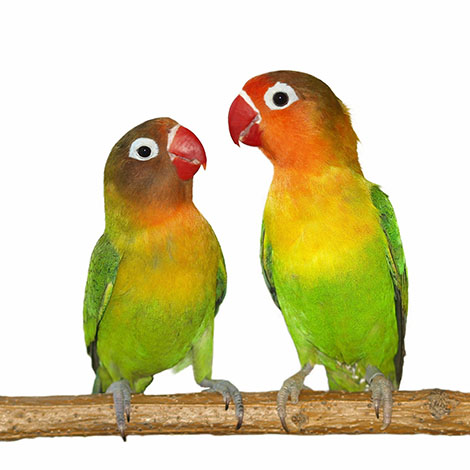 Lovebirds of a feather stick together
Lovebirds of a feather stick together
Lovebirds take mating-for-life very seriously. Most other ‘faithful’ birds rediscover their independence outside the breeding season, but Lovebirds live up to their name 24/7, 365 days a year.
Like most parrot species, in the wild all nine species of Lovebird live in flocks, and their social organisation is based on pairs. The strong bonds involved prevent bickering and fighting in the mating season. It’s a peace-keeping system that works so well, it’s surprising that other species haven’t followed a similar evolutionary path.
Lovebirds are bonded to the point of jealously. They may be our perfect picture of avian affection, but they will fend off any intruders. It is recommended to keep pairs separate from other birds, rather than including them in a mixed aviary – unless you have a huge space in which grumpy or jealous birds can easily find space away from each other.
A bereaved Lovebird, or one kept on its own, will become depressed. It will pine, stop eating, squawk, and become irritable. The exceptions are those birds that have been handled from a young age and have bonded with their human companion. Their affection is every bit as genuine with a human ‘partner’ as a feathered one.
There are downsides to this, though. A bonded lovebird will regurgitate food for you, and will need discouraging from attempting to mate!

Zebra Finches – Lovebirds of the Finch world
Most birds that live in flocks are monogamous – that is, they have just one mate each breeding season – but the Zebra finch takes it a step further. Many owners think the bird’s habit of mating for life is something that only happens in captivity, where choice of partner is restricted. But the little Zebra is every bit as faithful as the Lovebird, even in the wild.
In captivity problems can arise when birds die, or when new ones are added. A singleton in a group of Zebra finches will find it hard to find a mate without a fight. For this reason, ironically, it is actually best to keep these finches in pairs rather than big or odd-numbered flocks, as a single bird may be forced to become either a bully or a depressed outcast.
Love is in the air
Nature has found all sorts of ways of ensuring that the next generation of birds takes to the wing. At one end sit the cuckoos, taking no responsibility for parenting or relationships of any sort. Next come those birds that take the lots-of-mates approach. Most, however, opt for one partner per season.
But there’s something particularly appealing about those few species that mate for life. For Lovebird and Zebra finch owners, romance is an everyday fact of life.

This entry was posted in Pets on February 6th, 2020 by linnearask
Guinea pigs have many little ways of showing how much they love you. They may not be as obvious as dogs or cats in this respect, but once you know the signs they’re actually quite easy to read.

Your Guinea Pig Likes Being Held
GPs are timid creatures by nature, so it takes a lot of confidence for them to come to you for stroking or holding. You can interpret that confidence as affection. To reach this stage you need to hand-tame your pet with care and patience. Once they’ve built the trust, they’ll bond with you. They won’t approach everyone in this way – it’s just you they love!

Your Guinea Pig Likes Being Hand-Fed
It will take a little while to reach this stage. Rather than holding a tasty treat in your hand and hoping for the best, it’s best to train the guinea pig in stages. Leave a little trail of treats, and call to your pet gently. Eventually they’ll make it to your hand, and once they’ve become accustomed to this contact, the special bond between pet and owner will be complete.

Your Guinea Pig Follows You Around
By nature, a guinea pig wants to hide from humans, freeze on the spot or run away. It’s a sign of affection when they become so comfortable with you that they happily follow you around. Even if there’s no treat waiting for them, at this stage in the relationship they’ll stay with you simply because they like you and you make them feel safe.

Your Guinea Pig Doesn’t Bite!
This may sound like an odd demonstration of love, but it’s actually a sign that your pet feels very comfortable in your presence. If the GP is in any way afraid or nervous, it will bite if you try to make contact. There are ways of getting round this nervous reaction; and before you know it, the instinct to bite will have been replaced by an urge to nibble your toes…!

Your Guinea Pig Nibbles You, Very Gently
Yes, nibbling is a sign of affection! It’s something these animals do to each other as part of their grooming and bonding. Nibbling your shoes or finger ends will come naturally, once they’re comfortable with you. It’s very different from a bite – so don’t simply stick a finger into the cage hoping for a nibble and getting a nasty surprise instead!

Your Guinea Pig Climbs On You
When a guinea pig loves you, you become one of its favourite ‘safe places’. Sit down with your furry friends and they will climb into your lap. Lie down, and they will climb onto you and explore.

Your Guinea Pig Comes To Say Hello
When your guinea pigs first arrive, they will run for cover when you approach their enclosure. Familiarity takes time and patience, and you have to lead the taming process yourself in a hands-on way. Start by holding your guinea pig correctly and comfortably. Continue with a bit of treat-training, and they’ll soon be running to greet you whenever they see you approach.

Your Guinea Pig Responds To Your Voice
Guinea pigs can’t recognise their own names, but they can come to recognise your voice. You should talk, quietly and gently, from the moment you first get them. Always chat to them during hand training and feeding. They will soon come to associate that voice with all that love, and will love you back by coming when you call – no matter what you actually call!

Your Guinea Pig ‘Talks’ To You All The Time
You’ve been talking to them constantly, and they will soon return the compliment. A Guinea pig that chatters to you is very happy indeed in your company.

Your Guinea Pig Just Can’t Stop Playing!
A happy affectionate Guinea pig will dance around your feet, or will perform what is known as ‘popcorning’. This involves jumping in the air, and then running in circles, turning, and repeating the whole wonderful exercise. What better way to demonstrate love than with a good helping of popcorn?
This entry was posted in Guinea Pigs on February 4th, 2020 by linnearask




 GREENS
GREENS




 Watching chickens scratch at the frozen ground or strut through the snow, you might wonder how they manage to keep their feet and legs warm. After all, this is one part of their body with no feathers to keep it cosy (unless you happen to have a feathery-legged breed such as the Cochin, Brahma or Silkie).
Watching chickens scratch at the frozen ground or strut through the snow, you might wonder how they manage to keep their feet and legs warm. After all, this is one part of their body with no feathers to keep it cosy (unless you happen to have a feathery-legged breed such as the Cochin, Brahma or Silkie).



 20.00 Spa Treatment
20.00 Spa Treatment
 What Makes Cats Sad?
What Makes Cats Sad?
 Lovebirds of a feather stick together
Lovebirds of a feather stick together










